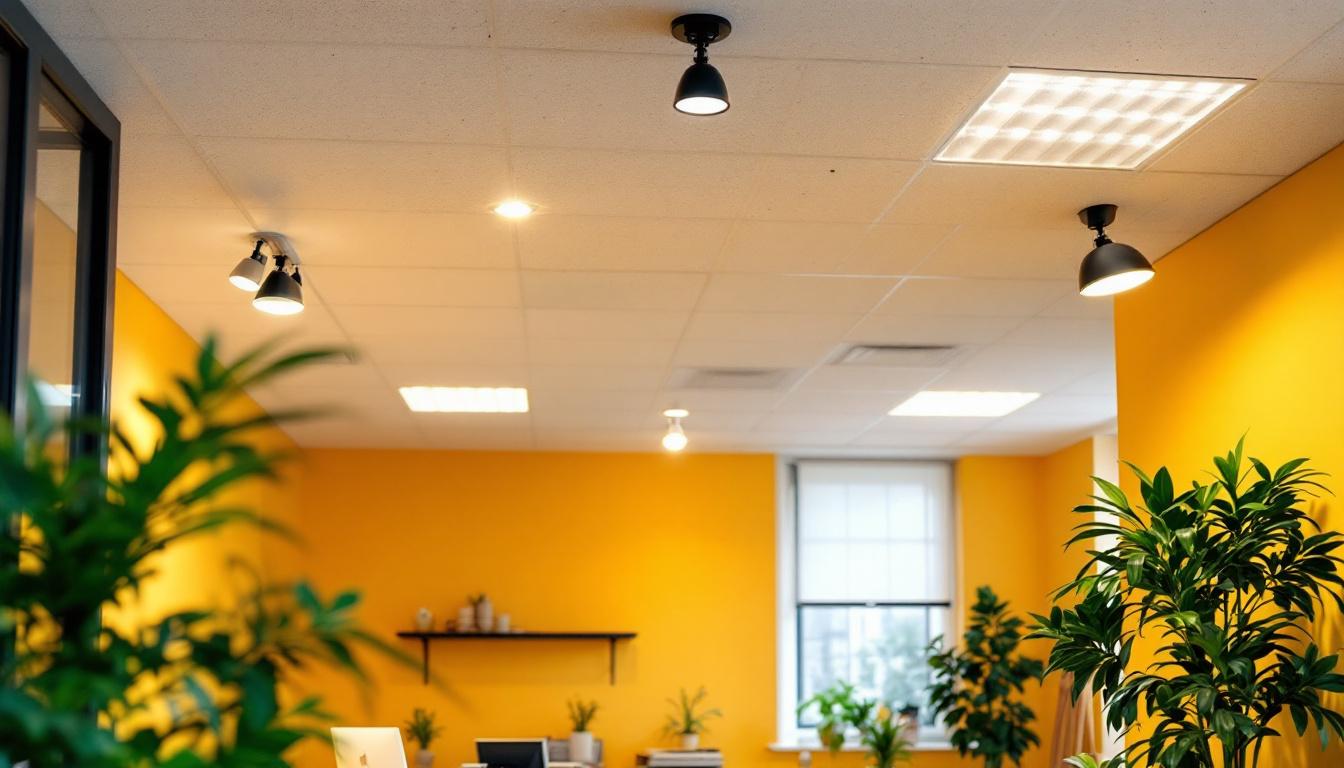
In the world of lighting design, drop ceiling lights, particularly the 2×4 fixtures, have become a staple in commercial and residential spaces alike. Their versatility and efficiency make them a popular choice among lighting contractors. However, despite their benefits, there are common pitfalls that can lead to costly mistakes in lighting projects. This article aims to shed light on these potential errors and provide guidance on how to navigate them effectively.
Drop ceiling lights, often referred to as troffers, are designed to fit into a grid ceiling system. The 2×4 size is particularly favored for its ability to provide broad illumination in large areas, making it ideal for offices, schools, and retail environments. Understanding the fundamental characteristics of these fixtures is essential for any lighting contractor looking to optimize their projects.
There are several types of drop ceiling lights available, each with its unique features and benefits. The most common types include LED, fluorescent, and incandescent fixtures. LED lights are increasingly popular due to their energy efficiency and longevity. In contrast, fluorescent lights offer a cost-effective solution but may require more frequent replacements. Incandescent options, while less common in commercial settings, still find use in specific applications.
Choosing the right type of drop ceiling light depends on the specific needs of the project, including budget constraints, desired ambiance, and energy efficiency goals. Understanding these differences can help contractors make informed decisions that align with their clients’ expectations. Additionally, the growing trend towards smart lighting solutions has introduced advanced options such as color-tunable LEDs, which allow users to adjust the color temperature and brightness according to the time of day or specific activities, enhancing both functionality and mood in the space.
The 2×4 drop ceiling lights provide several advantages that make them a preferred choice for many contractors. Their size allows for even light distribution across large spaces, reducing shadows and enhancing visibility. Additionally, they are easy to install and maintain, which can save time and labor costs during the project.
Moreover, the design of 2×4 fixtures allows for integration with various lighting controls, such as dimmers and occupancy sensors. This adaptability not only improves energy efficiency but also enhances the overall user experience in the space. The ability to automate lighting based on occupancy can significantly reduce energy consumption, making these fixtures not only a practical choice but also an environmentally friendly one. Furthermore, many modern 2×4 drop ceiling lights come with features like emergency backup options, ensuring that safety standards are met while providing peace of mind in case of power outages. This combination of functionality, safety, and efficiency makes 2×4 drop ceiling lights an excellent investment for any commercial or institutional setting.
Despite their advantages, lighting projects involving drop ceiling lights can be fraught with challenges. Understanding the common mistakes can help contractors avoid setbacks that may lead to increased costs and client dissatisfaction.
One of the most significant mistakes is failing to plan adequately before installation. A well-thought-out lighting design considers factors such as the purpose of the space, the layout, and the specific lighting needs of the occupants. Neglecting these elements can result in insufficient lighting, leading to an uncomfortable environment.
Contractors should conduct a thorough assessment of the space and engage with clients to understand their requirements fully. Utilizing lighting design software can also aid in visualizing the final outcome and ensuring that the lighting meets the intended goals. Furthermore, incorporating feedback from the occupants during the planning phase can provide valuable insights into how the space is used, allowing for a more tailored lighting solution that enhances both functionality and aesthetic appeal.
As energy costs continue to rise, ignoring energy efficiency in lighting projects can be a costly mistake. Many contractors may opt for cheaper fixtures without considering their long-term operational costs. This oversight can lead to higher electricity bills and increased maintenance expenses over time.
Investing in energy-efficient options, such as LED lighting, not only reduces energy consumption but can also qualify projects for rebates and incentives. Contractors should stay informed about the latest energy-efficient technologies and regulations to provide the best solutions for their clients. Additionally, educating clients about the benefits of energy-efficient lighting can foster a more sustainable mindset and encourage them to prioritize long-term savings over initial costs, ultimately leading to a more environmentally conscious project outcome.
Improper installation can lead to a myriad of issues, including flickering lights, uneven illumination, and even safety hazards. Contractors must adhere to manufacturer guidelines and local building codes to ensure a safe and effective installation.
Additionally, taking the time to train installation teams on best practices can significantly reduce the risk of errors. Regular inspections during the installation process can also help catch potential issues before they escalate. It is also beneficial for contractors to create a checklist that outlines critical installation steps and common pitfalls to avoid, ensuring that all team members are aligned and aware of the standards expected. This proactive approach not only enhances the quality of the installation but also builds a reputation for reliability and professionalism in the eyes of clients.
To avoid costly mistakes and ensure a successful lighting project, contractors should adopt several best practices that enhance both the quality of the work and client satisfaction.
Before embarking on a lighting project, conducting a comprehensive lighting audit is essential. This process involves assessing the existing lighting conditions, identifying areas that require improvement, and determining the specific needs of the space. By gathering this information, contractors can create a tailored lighting plan that addresses the unique challenges of the project.
A lighting audit should consider factors such as natural light availability, the activities that will take place in the space, and the preferences of the occupants. This thorough approach ensures that the final design not only meets functional needs but also enhances the overall aesthetic of the environment. Furthermore, it can reveal opportunities for energy savings by identifying underutilized fixtures or areas that could benefit from more efficient lighting solutions, ultimately contributing to a more sustainable design.
Incorporating advanced lighting technology can significantly improve the quality and efficiency of lighting projects. Smart lighting systems, for example, allow for remote control and automation, enabling clients to adjust lighting based on their preferences and needs.
Additionally, utilizing lighting design software can assist contractors in visualizing the final outcome, making it easier to present ideas to clients and gain their approval. Staying updated on the latest technologies and trends in the lighting industry can provide a competitive edge and enhance project outcomes. For instance, integrating LED technology not only offers energy efficiency but also allows for a wider range of color temperatures and dimming capabilities, which can be tailored to different activities throughout the day, creating a more dynamic and adaptable environment.
Effective communication with clients is crucial throughout the lighting project. Regular updates on progress, challenges, and changes to the original plan help build trust and ensure that clients feel involved in the process. This transparency can lead to greater satisfaction with the final outcome and reduce the likelihood of misunderstandings.
Moreover, soliciting feedback from clients during the project can provide valuable insights that may lead to improvements. Engaging clients in discussions about their preferences and expectations fosters a collaborative environment that can enhance the overall success of the project. Additionally, providing educational resources about lighting options and their benefits can empower clients to make informed decisions, ensuring that the final design not only meets their immediate needs but also aligns with their long-term vision for the space. This proactive approach can further solidify the contractor-client relationship, paving the way for future collaborations and referrals.
Compliance with local and national regulations is a critical aspect of any lighting project. Failure to adhere to these regulations can result in fines, project delays, and safety hazards. Contractors must stay informed about the relevant codes and standards that govern lighting installations.
Building codes vary by location and can encompass a wide range of requirements, including energy efficiency standards, safety regulations, and accessibility guidelines. Familiarizing oneself with these codes is essential for ensuring that projects meet legal requirements and can be completed without complications.
Contractors should also be aware of any updates or changes to building codes, as these can impact ongoing and future projects. Regular training and professional development can help contractors stay current with industry standards and regulations.
Safety should always be a top priority in lighting projects. This includes ensuring that all installations are performed safely and that the fixtures used meet safety standards. Contractors should conduct thorough inspections of all materials and equipment before installation to mitigate risks.
Additionally, providing safety training for installation teams can help prevent accidents and ensure that everyone involved in the project understands the importance of safety protocols. By prioritizing safety, contractors can protect their teams and clients while enhancing the overall quality of their work.
Drop ceiling lights, particularly the 2×4 fixtures, offer a multitude of benefits for lighting contractors. However, avoiding costly mistakes requires careful planning, adherence to best practices, and a commitment to quality. By understanding the common pitfalls and implementing strategies to mitigate them, contractors can enhance their project outcomes and ensure client satisfaction.
Ultimately, the success of a lighting project hinges on a contractor’s ability to navigate the complexities of design, installation, and compliance. By focusing on thorough planning, effective communication, and a commitment to safety and efficiency, contractors can elevate their projects and build a reputation for excellence in the lighting industry.
Ready to enhance your lighting projects with the best in spec-grade lighting? Look no further than LumenWholesale. Our commitment to quality and affordability ensures that you can access a vast selection of top-quality lighting products at wholesale prices that simply can’t be beaten. Say goodbye to middleman markups and hello to reliable, high-performance lighting that meets the highest industry standards. Plus, with free shipping on bulk orders, you can get the premium lighting you need at the best value — without any hidden fees. Elevate your lighting projects today and experience the best value in wholesale lighting with LumenWholesale.

Discover why LED recessed lights are essential for any successful lighting project.

Discover expert insights from top lighting contractors on optimizing salon lighting.

Discover how innovative bakery fixtures can provide lighting contractors with a competitive edge.

Discover why lighting contractors should prioritize industrial ceiling fans for garages.